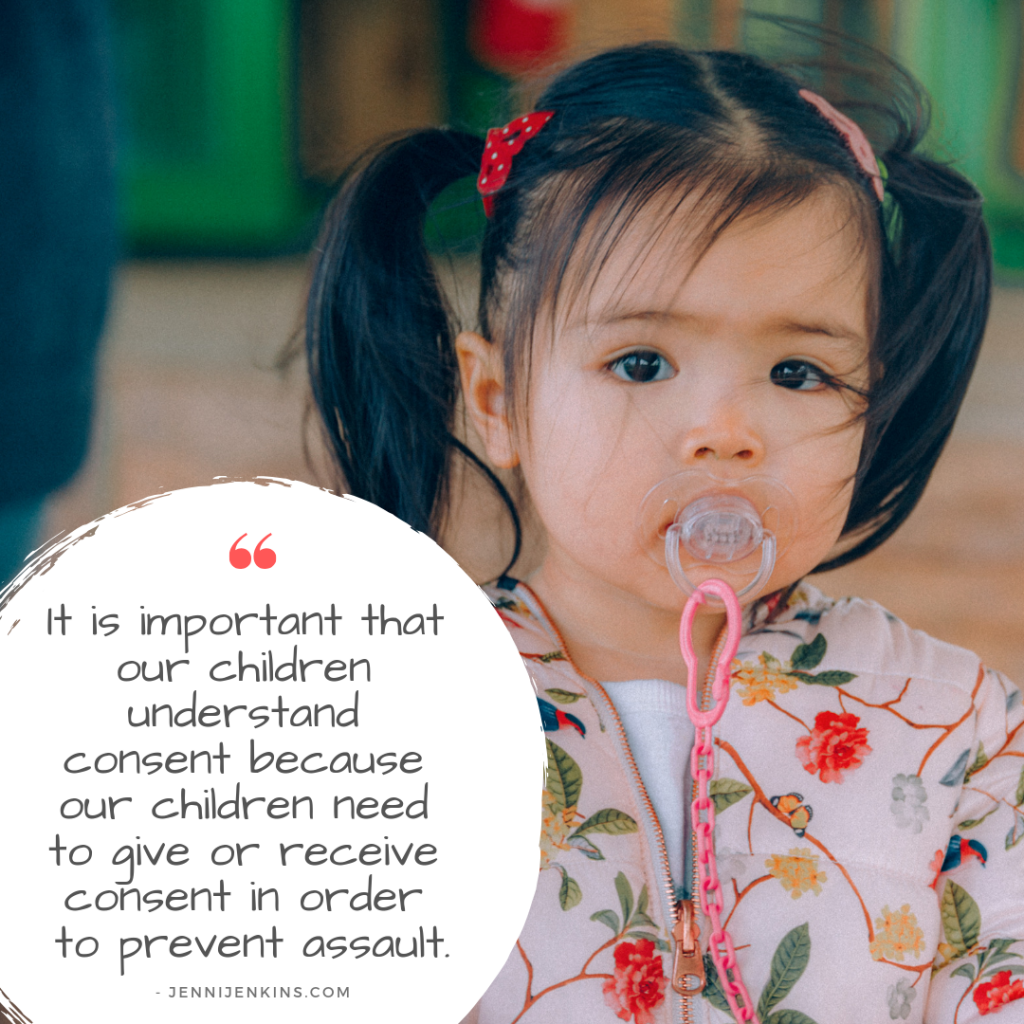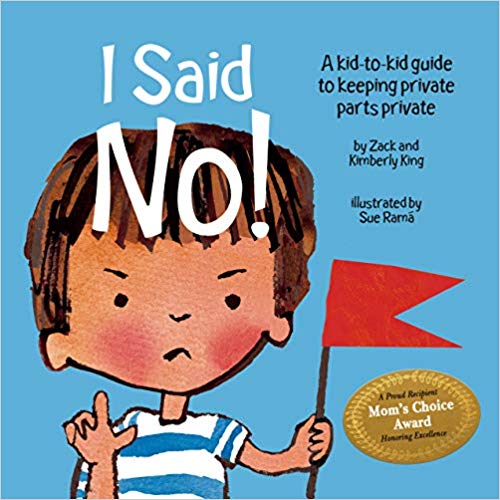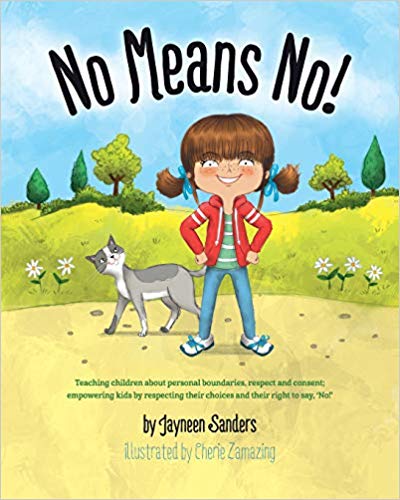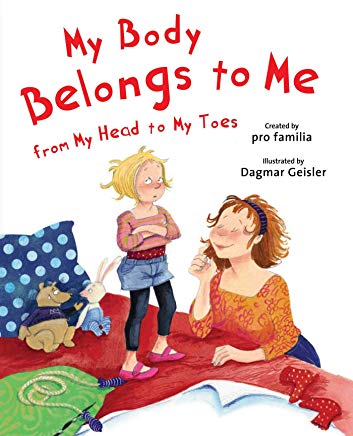A substantial proportion of U.S. female and male adults have experienced some form of sexual violence, stalking, or intimate partner violence at least once during their lifetimes (1). It is a fact that most of us have or will experience sexual violence. We can prevent this by teaching our children consent and modeling consent behavior.
Why Should We Teach Children Consent?
Statistically, it is likely your child will experience sexual assault, regardless of their gender. A substantial proportion of sexual violence, stalking, and intimate partner violence is experienced at a young age, primary prevention of these forms of violence must begin early (1). By informing our children about consent, we are arming them with tools, such as boundaries, to aid them in keeping their bodies and minds safe from perpetrators, from childhood into adulthood. An estimated 78.7% of women and 71.0% of men who are raped, were raped before age 25(1). Research also shows that victimization as a child or adolescent increases the likelihood that victimization will reoccur in adulthood (1).
In short, This knowledge could mean the world to your child’s future health and safety.
There is a critical need for primary prevention to focus on promoting healthy relational behaviors and patterns that can be carried forward into adulthood.

It is important that our children understand consent because our children need to give or receive consent in order to prevent assault. Sexual assault is defined as any sexual activity involving a person who does not or cannot (due to alcohol, drugs, or some sort of incapacitation) consent. Sexual assault can be “verbal, visual, or anything that forces a person to join in unwanted sexual contact or attention”(2). Rape does not always happen from strangers, it can occur in relationships and not every child, teen, or adult understands that even if you are in a relationship, your consent/your partners consent still matters immensely. The lifetime prevalence of physical violence by an intimate partner was an estimated 31.5% among women(1)
Consent culture isn’t exclusive to sex or sexual activity.
Boys & Girls Both Need Consent Culture
Research has documented at least 1 in 6 boys will experience some form of sexual abuse before turning age 18 (1). In 2014, the Centers for Disease Control estimated that over the course of the lifespan at 1 in 4 males overall will experience some form of sexual trauma (2)
Now that we are aware of the importance of consent culture knowledge, let’s talk ways to teach it to your kiddos!
1. Ask for Consent & Respect The Answer
You can teach your child or children how to ask for consent, give consent, and why it is so important. These lessons can begin as early as toddler stages. For instance, your three year old wants to hug their friend but that child is not comfortable with physical touch. If that child says they do not want a hug, explain to your child that they deserve to have their boundaries and wishes respected. Not only is this a great way to learn healthy boundaries, children with autism, aspergers, sensory sensitivities, and etc will greatly appreciate not being triggered by unwanted touch.

2. Stop means Stop. No Means No
As much as it is crucial that your child learns to respect other peoples ‘No’s’, They also need to see this reciprocated. You can teach your child all day long that they cannot rough house with a friend if that friend says no, but it will not mean anything if the adults in that child’s life are not modeling this behavior as well.
It is important for a child, and their family members, to understand the power of ‘No’. Empowering our children with the ability to say ‘No’ about their body boundaries, is a priority. You may need to support your child’s ability to say no to family and friends early in their life just as you will have to explain to your child what No means and how important consent is. It is relatively progressive to teach a child that they can tell Uncle Todd, “No. I do not want to be tickled.” and expect that uncle to respect the child’s request.

3. Teach Boundaries & Assist in Enforcement
This is a big one for me personally. Teach your child that it is OKAY to not want to hug, kiss, touch, etc Even With Family Members. Family members should especially respect consent with children! If you are confronted about your child being ‘bratty’ or your child’s request for their boundaries to be respected are being met with emotional manipulation tactics such as ‘but you will make auntie/grandma/cousin cry!’, express how crucial it is for your child’s request to be respected.
What I find most interesting is adults will often manipulate children into receiving affection, but when those same kids jump or play with the adult, the adult will become upset their space it not being respected. Consent is a two way street. Also, let us not forget that most child abusers are someone a child knows closely. Family are our child’s first interaction with society, it is so important that members of your family model healthy relational behaviors and patterns that can be carried forward into adulthood.
4. Use Proper Terms & Language
Talking to kids about their bodies with anatomically correct terms can prevent body shame and encourage a child to have a healthy view of their own body. Teaching children the proper terms for their anatomy promotes positive body image, self confidence, and parent-child communication; discourages perpetrators; and, in the event of abuse, helps children and adults navigate the disclosure and forensic interview process(3). Unfortunately, parents need to make sure they are arming their children with the knowledge they need to stay safe, and knowing proper terminology in the case of something happening, can keep your child safe and incriminate an abuser.
5. Begin the Conversation Early & Continue it into the Teens
There are so many books that explain consent to children through pictures and stories. These books could be wonderful tools for teaching your children in a way that might speak better to them, especially when they are little kiddos. After beginning this crucial conversation with your child(ren), it is equally important to keep the convo going throughout their development. Cultivating a trusting and supportive family environment will encourage your child to reach out when they need to discuss their body, questions about consent, or if someone has violated their consent.
Resources for Further Education on Consent.
- Safety Support for Parents from RAINN
- Title IX for Survivors This space was created to empower survivors and allies to fight for institutional reform in the handling of cases of sexual violence
- RAINN (Rape Abuse & Incest National Network ) Whether you’re looking for support, information, advice, or a referral, their trained support specialists are ready to help.
- MaleSurvivor Providing resources and support to male victims of sexual assault as well as working to expand the awareness of male sexual assault.
- Pandora’s Project nonprofit organization dedicated to providing information, support, and resources to survivors of rape and sexual abuse and their friends and family.
- Facts About Male Sexual Abuse
- Title IX for Survivors This space was created to empower survivors and allies to fight for institutional reform in the handling of cases of sexual violence
- Facts About Male Sexual Abuse







